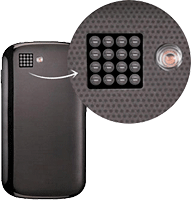Pelican Imaging demos Lytro-like refocusing in an inexpensive, slim smartphone-friendly module
posted Tuesday, April 30, 2013 at 10:51 PM EST

Are you thrilled by the possibilities of the Lytro light field camera, but less so by its extremely low resolution, bulky chassis, and relatively expensive pricetag? If so, a new tech from Pelican Imaging -- recently previewed by the folks at Extreme Tech -- might prove more attractive.
The Pelican array camera provides much the same after-the-fact refocusing capability as the Lytro or other plenoptic cameras, but it does so while still retaining a reasonably high eight megapixel output resolution, and in a self-contained package just a tenth of an inch (3mm) thick which doesn't need a separate lens. Further increasing its chances of seeing the light of day in a shipping product, the Pelican array camera is fairly affordable, with a predicted pricetag under US$20 in volume.
And just like the Lytro, the advantages of the array camera's design go beyond simply letting you tweak focus after the fact. Perhaps most significantly, shutter lag is greatly reduced by negating the need to focus automatically or manually before the shutter is released. And unlike the Lytro, Pelican's camera allows video capture as well, providing for absolutely silent and immediate focus adjustment on the fly. You can even select multiple subjects in the frame and ensure that they're both focused correctly simultaneously.
Images captured with the camera also include a depth map, potentially opening up all sorts of possibilities that the typical "flat" still image lacks. If it has sufficient resolution and depth, for example, the depth map could be used to greatly simplify the task of masking the subject and isolating it from the background. It could also be used to allow you to make depth-based adjustments to the image -- perhaps dialing back saturation for subjects further from the camera, or correcting for flash dropoff by adjusting the tone curve differently depending on subject distance.
So is there a catch? Yes, but it's one photographers already accept en masse in the interests of a more pocket-friendly smartphone. Pelican's technique nixes the possibility of including a zoom lens, limiting you to one specific focal length. Of course, you can always crop your image after the fact, but you lose resolution by doing so. And smartphones already ship predominantly with prime lenses, so it's clearly not a showstopper.
So far, Pelican is just showing the array camera to manufacturers and potential partners, as well as to the press. There is as yet no specific product launch or public availability date planned. We'd note, though, that Qualcomm and Nokia have just revealed an investment in Pelican that makes it all the more likely we'll see a refocusable camera in a smartphone, sooner or later.
Read the preview at Extreme Tech for more on the Pelican array camera.